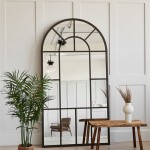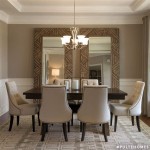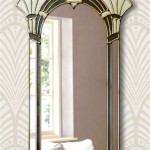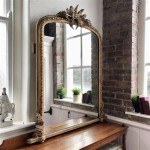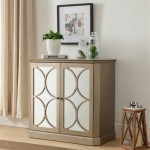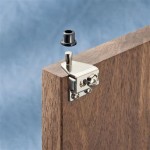Antique Cheval Mirrors: A Timeless Reflection of Elegance
The antique cheval mirror, also known as a horse mirror, stands as a captivating piece of furniture history, reflecting not only the viewer's image but also the aesthetic sensibilities of past eras. Distinguished by its full-length mirror mounted on a pivoting frame, allowing for adjustable viewing angles, the cheval mirror transcends mere utility; it embodies craftsmanship, artistry, and societal trends prevalent during its production.
While the exact origins of the cheval mirror remain debated, its widespread popularity began to blossom in the late 18th century and continued throughout the 19th century. This period coincided with significant advancements in glassmaking technology and furniture design, contributing to the refinement and diversification of the cheval mirror. Initially favored by the aristocracy and upper classes, its presence in grand residences served as a symbol of status and discerning taste. Over time, as manufacturing processes became more efficient, cheval mirrors became accessible to a broader segment of the population, finding their way into middle-class homes and even fashionable dressing rooms.
The value of an antique cheval mirror is contingent upon a multitude of factors, including its age, provenance (history of ownership), rarity, condition, materials used, and the craftsmanship involved in its creation. Mirrors originating from renowned furniture makers or possessing historical significance often command higher prices. Additionally, the presence of original hardware, intact gilding, and minimal restoration work significantly impact its market value. Understanding these elements is crucial for both collectors and those seeking to appreciate the historical and artistic merit of these reflective treasures.
Understanding the Key Elements of Antique Cheval Mirrors
Several essential characteristics define and distinguish antique cheval mirrors. Recognizing these features can aid in dating a piece, determining its quality, and appreciating its artistic significance.
Construction and Materials: The construction techniques and materials employed in creating an antique cheval mirror offer significant clues to its age and origin. Early examples often featured frames crafted from solid hardwoods such as mahogany, walnut, or rosewood. These woods were meticulously carved and joined using traditional woodworking methods like dovetailing and mortise-and-tenon joints, showcasing the skill of the cabinetmaker. The mirror glass itself warrants inspection. Older mirrors often exhibit slight imperfections and a "wavy" quality due to the manufacturing processes of the time. The backing of the mirror might be made of wood or, later, a composite material. The pivot mechanism, vital for adjusting the mirror's angle, can provide insights into the craftsmanship and design of the piece.
As furniture production evolved, so did the materials and techniques used in cheval mirror construction. The Victorian era saw the introduction of more ornate designs and the incorporation of materials like giltwood, ebonized wood, and even inlaid decorative elements such as mother-of-pearl or semi-precious stones. The use of veneers became more common, allowing for the simulation of more expensive woods on a less costly substrate. Examining the quality of the materials, the joinery, and the overall construction provides valuable information about the age, quality, and provenance of the cheval mirror.
Style and Design: The style and design of an antique cheval mirror are indicative of the prevailing aesthetic trends of its era. Each period left its distinct mark on the form, ornamentation, and overall appearance of these mirrors.
For instance, cheval mirrors from the late 18th century often reflected the Neoclassical style, characterized by clean lines, symmetrical forms, and restrained ornamentation inspired by ancient Greek and Roman motifs. These mirrors might feature fluted columns, delicate carvings of swags or garlands, and a generally understated elegance.
The 19th century witnessed a proliferation of different styles, including the elaborate Rococo Revival, the Gothic Revival with its pointed arches and trefoil details, and the Empire style with its bold lines and classical motifs. Victorian-era cheval mirrors frequently boasted elaborate carvings, intricate inlays, and a generally more opulent aesthetic. Recognizing the stylistic features associated with different periods is crucial for dating and appreciating the artistic merit of an antique cheval mirror.
Hardware and Details: Even seemingly minor details like the hardware and decorative elements can offer valuable clues about the age and authenticity of an antique cheval mirror. The type of screws used, the design of the hinges, and the style of any decorative mounts can all provide insights into the manufacturing practices and aesthetic sensibilities of the period in which the mirror was made. Original hardware is highly prized by collectors, as it contributes to the overall integrity and historical value of the piece. Furthermore, the presence of original labels or maker's marks can significantly enhance the desirability and value of an antique cheval mirror, as they provide concrete evidence of its origin and authorship.
Examining these details requires a keen eye and a knowledge of antique hardware styles. For example, hand-forged screws, common in earlier pieces, differ significantly from the mass-produced screws found in later examples. The design of decorative elements, such as finials or carved ornaments, can also reflect the stylistic trends of a particular period. Meticulously inspecting these details can help determine the authenticity and provenance of an antique cheval mirror.
Caring for an Antique Cheval Mirror
Preserving an antique cheval mirror requires a delicate balance between maintaining its original character and preventing further deterioration. Proper cleaning, handling, and storage are essential for ensuring its longevity and preserving its value.
Cleaning and Maintenance: The cleaning of an antique cheval mirror should be approached with caution and sensitivity. Harsh chemicals and abrasive cleaners should be strictly avoided, as they can damage the delicate surfaces of the frame and the mirror glass. A soft, lint-free cloth dampened with a mild solution of water and gentle soap is generally sufficient for cleaning the frame. For giltwood frames, a dry dusting with a soft brush is recommended to avoid damaging the gilding. The mirror glass can be cleaned with a specialized glass cleaner designed for antiques, applied sparingly to avoid streaking or damaging the silvering on the back.
Regular dusting and gentle cleaning are essential for preventing the buildup of dirt and grime, which can accelerate the deterioration of the materials. Avoid placing the mirror in direct sunlight or near sources of heat or humidity, as these can cause warping, cracking, or discoloration. Inspecting the mirror regularly for signs of damage, such as loose joints or flaking gilding, allows for early intervention and prevents further problems.
Handling and Storage: When moving or storing an antique cheval mirror, it is crucial to handle it with care to avoid damage. The mirror should be carefully wrapped in protective padding, such as bubble wrap or moving blankets, to prevent scratches or impacts. The frame should be supported to prevent stress on the joints. The mirror should be transported upright to minimize the risk of breakage. When storing an antique cheval mirror, choose a location that is dry, well-ventilated, and protected from extreme temperatures and humidity fluctuations.
If the mirror is to be stored for an extended period, consider covering it with a breathable dust cover to protect it from dust and light. Avoid storing the mirror in a damp basement or a hot attic, as these environments can promote mold growth and material degradation. Proper handling and storage are essential for ensuring the long-term preservation of an antique cheval mirror.
The Investment Potential of Antique Cheval Mirrors
Beyond their aesthetic appeal and historical significance, antique cheval mirrors can also represent a sound investment. The market for antique furniture, including cheval mirrors, has demonstrated resilience over time, with certain pieces appreciating significantly in value. Factors that influence the investment potential of an antique cheval mirror include its rarity, condition, provenance, and the overall demand for pieces from its specific period or style.
Rarity and Provenance: Rarity plays a crucial role in determining the investment potential of an antique cheval mirror. Mirrors produced by renowned furniture makers or those with documented historical significance often command higher prices. Limited production numbers, unique design features, and exceptional craftsmanship all contribute to the rarity of a piece and its potential for appreciation. Provenance, or the documented history of ownership, can also significantly enhance the value of an antique cheval mirror. A mirror with a well-documented provenance, linking it to a prominent historical figure or a notable collection, is generally more desirable to collectors and investors.
Condition and Restoration: The condition of an antique cheval mirror is a critical factor in determining its investment value. Mirrors in excellent original condition, with minimal restoration work, are generally more highly prized. While some restoration may be necessary to address structural issues or surface damage, excessive or poorly executed restoration can diminish the value of the piece. Maintaining the original hardware, finish, and details is crucial for preserving the integrity and authenticity of the mirror. A carefully restored antique cheval mirror can be a valuable investment, but it is essential to ensure that the restoration work is performed by a qualified professional using appropriate techniques and materials.
Market Trends and Demand: The market for antique furniture, including cheval mirrors, is subject to fluctuations based on changing tastes, economic conditions, and collector preferences. Certain periods or styles may be more popular at different times, influencing the demand for specific types of cheval mirrors. Staying informed about current market trends and the preferences of collectors and interior designers can help to assess the investment potential of an antique cheval mirror. Consulting with experienced antique dealers, appraisers, and auction houses can provide valuable insights into the market and help to make informed investment decisions. While predicting future market trends is impossible, understanding the factors that influence the value of antique cheval mirrors and following market developments can increase the likelihood of a successful investment.
Huge Victorian Cheval Mirror Large Tilting Dress 2950 00 Yvonne Sanders Antiques Ltd Auckland Furniture

Very Nice Mahogany Cheval Mirror In Antique Mirrors
French Antique Wooden Cheval Dressing Mirror

Vintage Cheval Mirror Wells Reclamation

Antique Mahogany Cheval Mirror Dressing Large Chevel Mirrors Swing Toilet And

115 Antique Cheval Mirrors For Ingantiques Co

Antique Mahogany Cheval Mirror C1920 261183 Www Castleforgeantiques Co

Qw Amish Antique Oval Cheval Mirror Quality Woods Furniture

Antique Cheval Mirrors

Antiques Atlas Victorian Mahogany Cheval Mirror As402a1334

